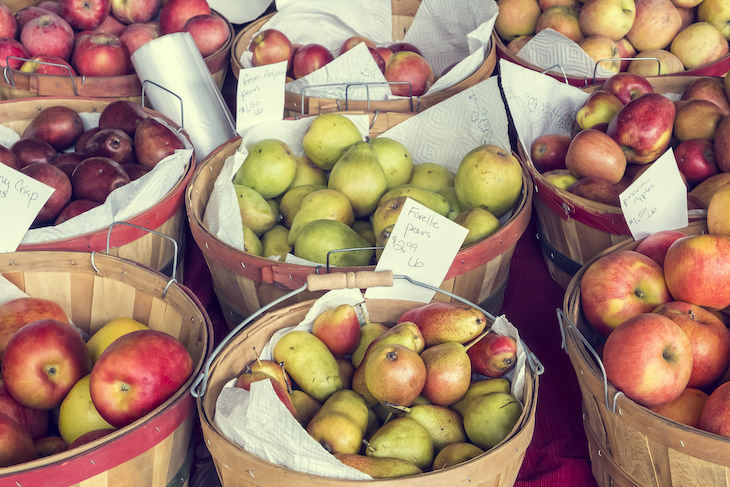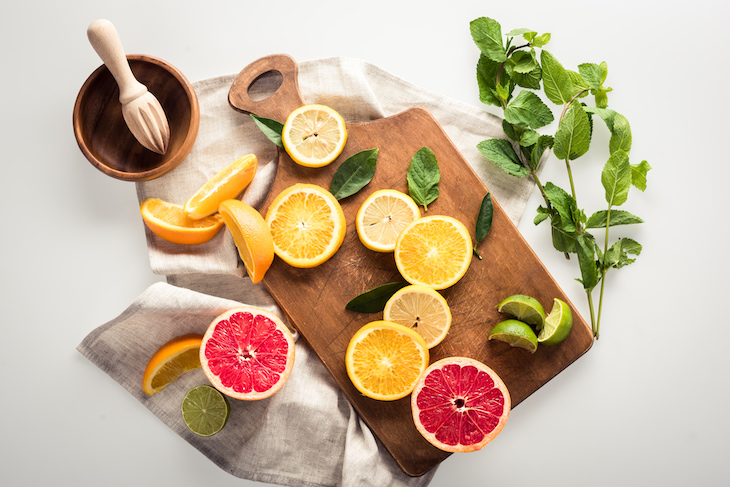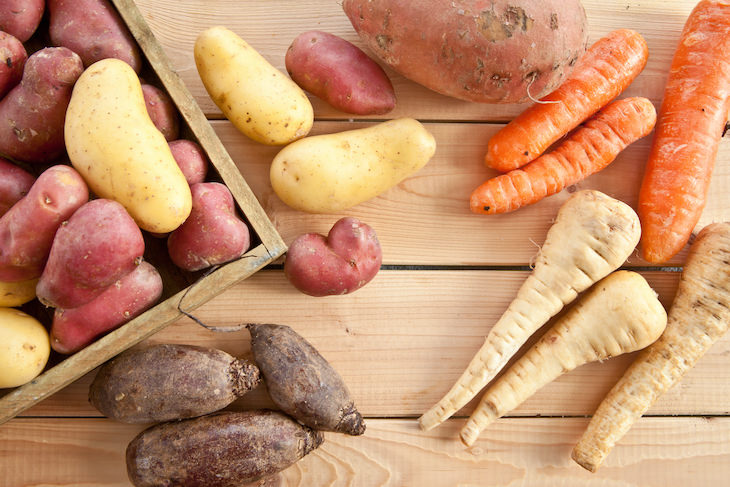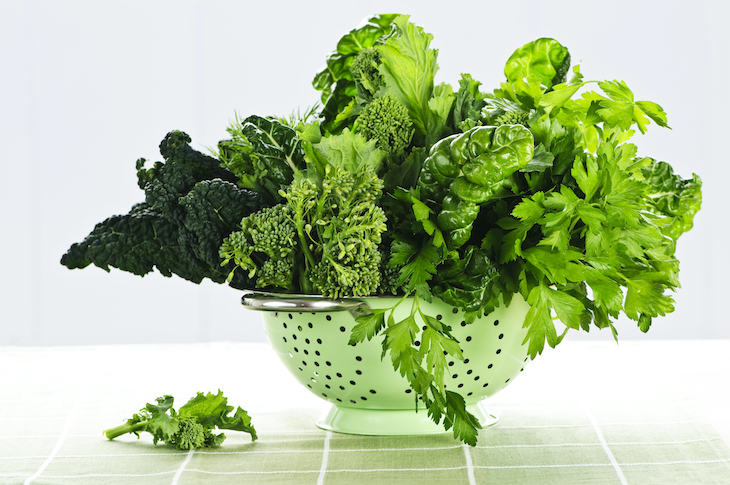
The colder months of the year are usually not associated with fresh produce, and we tend to think of summer and fall as the peak of the harvest season. But not all is bleak in these cold months. Although most fields look fallow towards the end of every winter, there are still plenty of delicious fruits and vegetables that are right in season. You just need to know what to look for.
To help you pick and choose the best products on your next shopping trip, we rounded up all the fruits and vegetables that are in their prime around the end of winter and the beginning of spring. These guidelines will help you determine the quality of the fresh produce before you buy it.
Related: Seasonal Fruits & Vegetables Guide

When it comes to winter fruits, apples are probably the most popular. Besides being delicious, apples are also a practical fruit, as they have a long shelf life - they can be stored for eight weeks or longer. In fact, the flavors of Pink Lady and Granny Smith apples develop during storage, so they will actually taste better a few weeks after they're picked. The apples you will find in the grocery store in late winter and early spring have plenty of time to age, so they are likely to be very flavorful.
Pears are the second on the list of popular winter fruits. To find the best ones, experts advise looking out for hydration first and foremost - the water content is responsible for the balance of flavors. Unlike apples, pears only last around three to five days when chilled, and even less at room temperature, so don’t wait for too long to eat them.
When shopping for apples and pears, pay attention to the skin - dullness may indicate that the fruit is past its prime. Opt for apples and pears that are free of blemishes and feel firm when you grip them. In general, holding fruits and vegetables is a good method to test their quality. If the fruit feels heavy for its size, it means that there is plenty of juice inside, and it’s not too old or dried out.
For apples and pears especially, you want to double-check that the skin is smooth and unblemished because cuts and bruises can lead to the spread of bacteria and mold.

Grapefruits, oranges, clementines, and other citrus fruits are often harvested during the winter months. The harvest season for citrus fruits extends into early spring, too. What should you look for to choose the best citrus fruits? It depends on the type of fruit. For oval-shaped citruses like lemons and limes, choose the ones that surrender slightly when squeezed - they’ll have less bitter pith. Go for brightly-hued lemons and limes, and check for any brown spots - these indicate that they are past their prime.
For spherical citrus fruits, on the other hand, color vibrancy means much less. That is particularly true for mandarins. When you’re shopping for those, your sense of smell should be the one that guides you. To test a mandarin’s quality, rub its skin lightly - you should get a fresh strong aroma, and ideally, you will have a little oil left on your skin.
With other citrus fruits, the best indicators are heft and the thickness of the skin. Remember, the thicker the peel, the smaller the yield.
Related: Pick the Freshest Vegetables with These Science Tips

Potatoes, sweet potatoes, and other root vegetables are perfect for the chillier months, and not only because they're so delicious and filling. According to culinary experts, the defense mechanisms root vegetables have against cold weather actually make them taste better. “The sugar drops to the roots of the plant to protect it when it gets cold, which is the part you’re eating!” chef Joseph Realmuto explained to Huffington Post.
When choosing sweet potatoes at the grocery store, look for smaller and broader ones. They have the best flavor. Longer, thinner sweet potatoes are more prone to be stringy. In general, for any variety of potatoes, you want the skin to be as clean, tight, and even as possible, with eyes that aren’t too deep or moist. Additionally, pay attention to any cuts and soft spots. The same goes for rutabagas, turnips, carrots, and parsnips.
Lastly, avoid potatoes that show signs of sprouting. It means they haven’t been stored properly, and they could be unsafe to eat.

While onions are considered a root vegetable, we decided to give them their own separate section, as choosing good quality onions requires a few extra tips. Knowing how to select onions is important: they are a must-have ingredient that enhances the flavor of almost any dish and is in use year-round.
When picking out onions, make sure that they are dry and papery to the touch. This is important because onions that exude moisture are usually damaged, and this moisture will quickly deteriorate to mold and rot. Shiny and clear skins are other indicators of fresh-tasting and juicy onions.
Related: What You Need to Know About Different Types of Onions!

Generally, leafy greens can be divided into two categories. Light greens like lettuce, spinach, and arugula are prevalent during the summer and spring months. The second category includes hardy, fibrous winter greens like kale, curly endives, radicchio, and fennel.
Let’s start with the second option. For winter greens, the vibrancy of their color is the trait you want to look for - lush purple in radicchio, bright white in endives, bold yellow and pink in Swiss chard, and of course, deep green in kale leaves. Another detail to pay attention to are the edges of the leaves. If they appear light yellow or brown, it’s a sign of age.
Your goal is to get the most recently-harvested green, and the best trick to spot these is to check the stem. “Look for a fresh cut. Something that is brown or black in color, or corky to hard in texture has been out of the field for some time,” says produce specialist Patrick Adhern.
As for spring greens, choose the ones with crisp, firm, and unblemished leaves and no yellowing on the ends. Bright colors play an important role here, too.

The stem rule also applies to brassicas - cruciferous vegetables such as broccoli, cauliflower, Brussels sprouts, and cabbage. Dry or split ends are a sign of decay. The florets of broccoli and cauliflower should appear in a dense cluster, and the sprouts and the cabbage leaves should be close together.
As for the shade - Brussels sprouts and cabbage should be moderately green. They shouldn't look washed out but not overly dark either, as that means they were left in the field longer than ideal. Broccoli florets vary in shades of green, but if you spot a hinge of yellow, leave them on the shelf.
One trick for testing broccoli is to snap off a floret and see if a layer of stalk peels off with it. If it does, it means that the broccoli was harvested too late and it’s best to find a different one. Cauliflower is more straightforward. Look for the ones that are cream-colored, with little to no gray or brown discoloration and pale green leaves. You can cut off the dark bits when they start to develop, but once they get mushy or dark, it’s time to throw them out.
Share these tips with others!